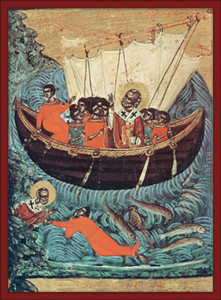St Nicholas the Wonderworker

In the old days (ie. Old Testament), the incorporeal and infinite God was never depicted. Now, however, when God has been seen clothed in flesh, and talking with mortals, I make an image of the God whom I see. I do not worship matter, I worship the God of matter, who became matter for my sake, and deigned to inhabit matter, who worked out my salvation through matter.
It is fitting that we remember St John of Damascus on December 4, three weeks before the Incarnation of our Lord. St John, the defender of icons during the iconoclast period in the 8th Century, wrote on how God becoming man validated the use of images to “worship the God of matter.”
Two days after St John’s feast day we celebrate St Nicholas, the holy Archbishop of Myra, Wonderworker, and Father of our Church – whose icon we will examine. St Nicholas is recognised by the faithful as the intercessor for seafarers. For this reason, fishermen, sailors and seaports throughout the world honour the saint.
The 14th Century church of St Nicholas ‘Orphanos’ is a half hour, uphill walk from the port of Thessaloniki. It is a church renowned for the well-preserved frescoes which have covered its interior walls since its 1310 to 1320 construction.
The first image that meets the pilgrim, directly opposite the entry and above the door to the nave, is the much repainted depiction of St Nicholas surrounded by fishermen in a boat. The fresco is damaged, however, to the right of the boat, St Nicholas is also depicted lifting a man out of the waves. It is symbolic that this icon rests above the door to the nave, as the word “nave” stems from the Greek word for “boat.” This reminds the worshipper that in entering the Church we enter the Ark of Salvation.
According to the Synaxarion, when travelling to the Holy Land St Nicholas calmed the winds of the storm which threatened the ship. Through his prayers he also healed one of the sailors who had fallen from the mast. After his death, the saint miraculously assisted many ships. In one account, likely the one depicted in the icon, he appeared at the helm of a ship caught in a storm and delivered it safely to port. Another account describes how a man who had fallen overboard called upon the saint and, to the astonishment of his family, found himself at his home.
Moreover, the image of the boat in iconography is frequently used to represent the Church with Christ as the Helmsman. In fact, in both of the depictions in the icon we are reminded of events in the life of Jesus: calming the seas, and lifting Peter out of the waves.
Through such icons we recognise that the beauty of iconography lies in its considered depiction of the life of Christ and the saints in assisting us to “worship the God of matter.” We call upon St Nicholas to strengthen and guide us so that we can navigate the storms and tribulations of life, and arrive at the port of our loving God with faith and reverence.
Source: Lychnos December 2020 – January 2021
